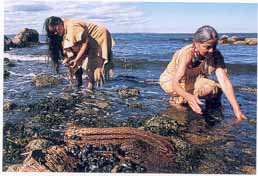The English didn't help themselves by attacking neutral Native Americans (who weren't really neutral because although they weren't fighting with Philip, they were tending to his sick and sheltering his women and children). Still, attacking the Narragansett and other "neutral" Native Americans spread the English forces thinner, making them easy picking for a determined Philip, who preferred ambush and quick strikes to open battlefield war. As the war dragged on, however, the calendar caught up with Philip. The winer of 1675 was deadly to his efforts, taking many of his finest warriors, who succumbed to starvation and illness during what was a very cold winter indeed. And because Philip and his warriors were moving around a lot, they weren't able to stay in one place long enough to plant new crops and reap the benefits of their harvest. The English, meanwhile, were able to rely on their larger, more populated settlements and capability for food production. With the new year came the end of King Philip's War. A series of English victories cut the Native American army in half, sending shockwaves into Philip's forces and turning them into a mass of separate tribes, looking out for their own homes, instead of a united force working together to oust a common enemy. The English closed in on Philip, who went into hiding in a swamp near his home of Mount Hope. A former friend revealed Philip's position to the English, and the Grand Sachem was killed on Aug. 12, 1676. The English didn't know when to stop, however, and had no interest in signing a peace treaty for another two years. During this time, they continued to hunt and ravage Wampanoag who were no longer fighting back. By the time that the fighting stopped, in 1678, the Wampanoag population was 400.
First page > First Meetings > Page 1, 2, 3, 4 |
|
Social Studies for Kids
copyright 2002–2026
David White



 Most of the neighboring Native American populations fled to Canada. The Wampanoag, no longer considered a threat, were allowed to remain in a few settlements, some of which exist today. The population these days exceeds 3,000. The settlements are these: Assonet, Gay Head, Herring Pond, Mashpee, and Namasket—all in Massachusetts. These settlements have endured an ever-growing United States and subsequents bouts with illness and suspicion. One, Gay Head, has been recognized by the U.S. Government.
Most of the neighboring Native American populations fled to Canada. The Wampanoag, no longer considered a threat, were allowed to remain in a few settlements, some of which exist today. The population these days exceeds 3,000. The settlements are these: Assonet, Gay Head, Herring Pond, Mashpee, and Namasket—all in Massachusetts. These settlements have endured an ever-growing United States and subsequents bouts with illness and suspicion. One, Gay Head, has been recognized by the U.S. Government.
